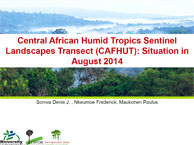Site selection
Mintom
Transition between mature old growth forest and logged-over forest, where there is a mixture of active forest concessions, recently allocated community forests and unallocated forest concessions.
Currently the site hosts both production and virgin primary forest, but a vast road is being opened through this area, meaning that a radical change can be observed in few years.
Activities include opening of markets and intensification of smallholder/community activities - including agriculture and agroforestry, hunting, informal logging and commercial activities.
Lomie-Kongo
Degraded mature forest, where Concession and community forestry and timber exploitation are some of the principal activities influencing forest structure in the area.
In addition to this, other forest-related activities include hunting and the collection of some non-timber forest products.
Agriculture and agroforestry practices exist, however access to markets is slightly more difficult, meaning that they have not been intensified.
A principal partner in the area would be the PALLISCO timber concession.
Ayos
The municipality of Ayos is situated 123 km from Yaoundé, the national capital of Cameroon. Ayos vegetation is characterized by galerian forests surrounded by swamp forests of raffia, and has a surface area is 1250 km2 with an estimated population of 22899 inhabitants.
The entire population of this municipality depend directly on subsistence farming for their livelihoods with cocoa being one of the principal agricultural produce. The zone falls in the forest margin landscape where agriculture and agroforestry products are the mainstay for a large proportion of the population, and agricultural practices are relatively mature (mostly cocoa, coffee, oil palm).
The presence of ASB site from ICRAF, with IITA as partner, is an assurance for available information about the dynamics in the area.
The area is inhabited by growing rural communities with access to markets, and comprises about 39 villages under two mains groups - YEBEKOLO-Est and OMVANG. Its geographical position provides avenue for the flow of money which is reflected in the progressive investments in activities such as fishing, hunting, small scale plantations (cocoa, oil palm, pineapple, etc.), and which supply local and neighbouring markets in Abong Mbang to the East and from Awae towards Yaoundé in the West.
Bokito
Forest-savannah or deforested landscape dynamic, where secondary forest is used for growing cash and subsistence agricultural and agroforestry crops.
All forest land has been allocated, so some have begun to successfully grow cocoa and oil palm in the savannah.
Site shows deforested landscapes, forest-savannah mosaics and successful reforestation efforts.
Good access by road, and a long-term CIRAD presence, ensuring links to local smallholders and some past data.
Research teams
LDFS
3 days training of 15 participants from ICRAF to expose them to the various methods and tools used in the characterization and mapping of ecosystems.
Field survey started already with Bokito (currently in Etiomolo) with the planning of ending this August before moving to Lomie
Lomie will be programmed after Bokito.
Socio-economic
9 Villages selected around Mintom site, using criteria such as: size, hospitality, accessibility, ethnic composition.
The method used: Census information's from local administration and partners; Random walk; key informants; focus group discussions.
Household list from focus groups and snowball used (138 household representing 25% of the total household).
IFRI survey tools used to gather information (Focus groups of 10-20 persons; Key informants leaders; Implication of women as much as possible).
Next step: Move to Bokito
Institutional Mapping
Several exchange with the methodology group
Meeting in Yaoundé to have a common understanding of the survey tools
Activities not yet started due to the non-availability of the group leader
A Consultant will be recruited to handle start the activities
Health
Initiated some field work at Ayos and Bokito.
Some sites visit conducted; to exchange with health related stakeholders (Health personnels, traditional authorities, traditional health offers, etc…).
Information collected comprised; distance to health centers, health personnels, plants and tree used for health treatment, household health situations etc..
Next step: discussed the finding with the sentinel landscape in the perspective of developing a methodological tools for this component.







